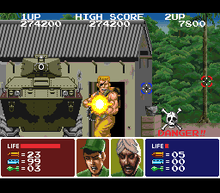Operation Thunderbolt (video game)
| Operation Thunderbolt | |
|---|---|
_titlescreen.jpg) Promotional flyer | |
| Developer(s) | Taito |
| Publisher(s) | Taito |
| Director(s) | Menahem Golan |
| Platform(s) | Arcade, Amiga, Super Nintendo Entertainment System, Commodore 64 |
| Release date(s) | 1988 |
| Genre(s) | Shooting gallery |
| Mode(s) | Single-player, 2 player Co-op |
| Cabinet | Upright |
| CPU | 68000 (@ 13 MHz) |
| Sound |
Z80 (@ 4 MHz) YM2610 (@ 8 MHz), (6x) Volume (@ 8 MHz) |
| Display | Raster, 320 x 240 pixels (Horizontal), 4096 colors |
Operation Thunderbolt is a one- or two-player shooter arcade game by Taito made in 1988. It is the sequel to Operation Wolf. Like its predecessor, the game uses mounted positional guns as controllers. It also adds two-player simultaneous play. Versions of the game were released for the Super Nintendo Entertainment System and various home computers. An arcade exclusive sequel to Operation Thunderbolt was released in 1994, Operation Wolf 3.
Gameplay
Roy Adams and Hardy Jones, two green berets, must save American hostages from a hijacked airliner which was forced to land in the fictional African province, Kalubya. To accomplish their mission, they must capture six different bases, shoot enemies such as soldiers, jeeps, tanks, and helicopters using their machine gun or grenade launcher, and try to save the hostages along the way. Enemies attack with bullets, grenades, or rockets. Killing the hostages by accident results in the player receiving a bad ending. Once Stage 8 is reached, the players must engage with the lead hijacker holding the pilot hostage. At this point continues are no longer permitted and if the player dies, he obtains a game over screen which is also seen when the player fails to insert coins before the continue timer reaches 0. The player can accidentally kill the pilot, which triggers a bad ending. If he kills the hijacker, the good ending is shown with the credits.
Ports
Operation Thunderbolt was ported to the following platforms:
- Amstrad GX4000
- Amstrad CPC 464
- Amstrad CPC+
- ZX Spectrum
- Commodore Amiga
- Commodore 64
- Super Nintendo Entertainment System
- Atari ST
- Xbox (as part of Taito Legends)
- PlayStation 2 (as part of Taito Legends)
- PC (as part of Taito Legends)

The Super NES version also works with the SNES Mouse[1] and the Super Scope. In addition, the player was able to choose from a variety of different characters. The storyline was altered in that the hijackers were members of a fictional country known as the Bintazi People's Republic, ruled by General Abul Bazarre, ruler for life. General Bazarre demands that his comrades be freed or else the hostages will be executed.
Reception
| Reception | ||||||||||||||||||
|---|---|---|---|---|---|---|---|---|---|---|---|---|---|---|---|---|---|---|
| ||||||||||||||||||
| ||||||||||||||||||
The game won the award for best graphics of the year according to the readers of Crash magazine.[9]
Reviewing the Super NES version, GamePro criticized the repetitiveness of the gameplay and the slowness of the aiming reticule, but praised the colorful and detailed graphics and strong sound effects, and concluded that "This Operation is a success, generating plenty of shootin' thrills for intermediate soldiers."[10] A reviewer for Next Generation dismissed it as "another shooting-gallery game, just like Operation Wolf ... It's good for a mild adrenaline rush - barely - but that's it."[7]
Connection to real events
Operation Thunderbolt was also one of the names used to refer to the Israeli Defense Forces' 1976 hostage rescue mission at Entebbe, Uganda, and also to a feature film dramatizing the same event. The game is arguably a very loose adaptation of the raid at Entebbe: The "North African province Kalubya" in the game is in a location in Africa that corresponds to the location of Libya in real life; the name of the province is an obvious corruption of Libya (possibly a portmanteau with Kaboom or Kablooey), and both involved hijacked airliners, hostages and a commando raid (the hijackers landed the plane in Libya to refuel before proceeding to Uganda; the game unifies the two locations).
See also
- Operation Wolf (1987)
- Space Gun (1990)
- Operation Gunbuster (1992)
References
- ↑ "Let's Get Technical". GamePro (66). IDG. January 1995. p. 14.
- ↑ http://www.worldofspectrum.org/showmag.cgi?mag=C+VG/Issue098/Pages/CVG09800100.jpg
- ↑ http://www.worldofspectrum.org/showmag.cgi?mag=Crash/Issue71/Pages/Crash7100063.jpg
- ↑ http://www.worldofspectrum.org/showmag.cgi?mag=SinclairUser/Issue094/Pages/SinclairUser09400103.jpg
- ↑ "Operation Thunderbolt". ysrnry.co.uk. Retrieved 2015-09-06.
- ↑ http://www.worldofspectrum.org/showmag.cgi?mag=ACE/Issue29/Pages/ACE2900048.jpg
- 1 2 "Operation Thunderbolt". Next Generation. Imagine Media (6): 113. June 1995.
- ↑ http://www.worldofspectrum.org/showmag.cgi?mag=TheGamesMachine/Issue25/Pages/TheGamesMachine2500086.jpg
- ↑ "CRASH 75 - Readers' Awards". crashonline.org.uk. Retrieved 2015-09-06.
- ↑ "ProReview: Operation Thunderbolt". GamePro (66). IDG. January 1995. p. 74.